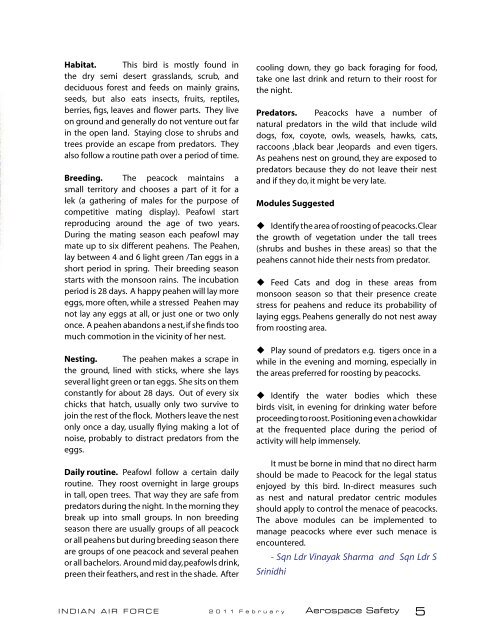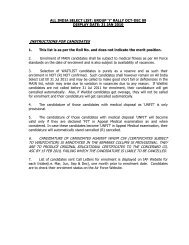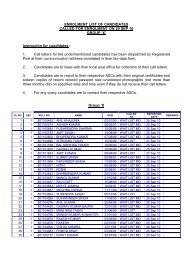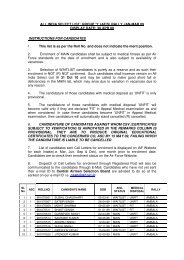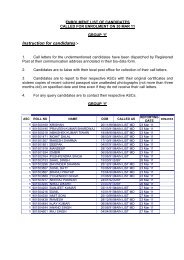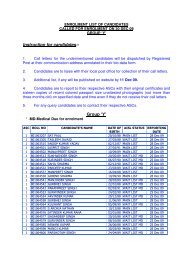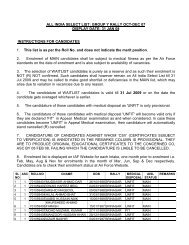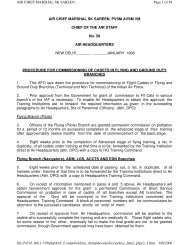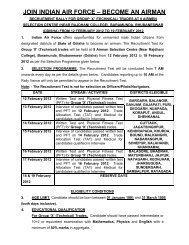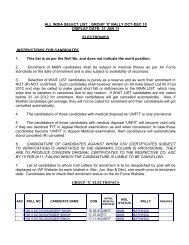February 2011 - Indian Airforce
February 2011 - Indian Airforce
February 2011 - Indian Airforce
You also want an ePaper? Increase the reach of your titles
YUMPU automatically turns print PDFs into web optimized ePapers that Google loves.
Habitat. This bird is mostly found inthe dry semi desert grasslands, scrub, anddeciduous forest and feeds on mainly grains,seeds, but also eats insects, fruits, reptiles,berries, figs, leaves and flower parts. They liveon ground and generally do not venture out farin the open land. Staying close to shrubs andtrees provide an escape from predators. Theyalso follow a routine path over a period of time.Breeding. The peacock maintains asmall territory and chooses a part of it for alek (a gathering of males for the purpose ofcompetitive mating display). Peafowl startreproducing around the age of two years.During the mating season each peafowl maymate up to six different peahens. The Peahen,lay between 4 and 6 light green /Tan eggs in ashort period in spring. Their breeding seasonstarts with the monsoon rains. The incubationperiod is 28 days. A happy peahen will lay moreeggs, more often, while a stressed Peahen maynot lay any eggs at all, or just one or two onlyonce. A peahen abandons a nest, if she finds toomuch commotion in the vicinity of her nest.Nesting. The peahen makes a scrape inthe ground, lined with sticks, where she laysseveral light green or tan eggs. She sits on themconstantly for about 28 days. Out of every sixchicks that hatch, usually only two survive tojoin the rest of the flock. Mothers leave the nestonly once a day, usually flying making a lot ofnoise, probably to distract predators from theeggs.Daily routine. Peafowl follow a certain dailyroutine. They roost overnight in large groupsin tall, open trees. That way they are safe frompredators during the night. In the morning theybreak up into small groups. In non breedingseason there are usually groups of all peacockor all peahens but during breeding season thereare groups of one peacock and several peahenor all bachelors. Around mid day, peafowls drink,preen their feathers, and rest in the shade. Aftercooling down, they go back foraging for food,take one last drink and return to their roost forthe night.Predators. Peacocks have a number ofnatural predators in the wild that include wilddogs, fox, coyote, owls, weasels, hawks, cats,raccoons ,black bear ,leopards and even tigers.As peahens nest on ground, they are exposed topredators because they do not leave their nestand if they do, it might be very late.Modules Suggested Identify the area of roosting of peacocks. Clearthe growth of vegetation under the tall trees(shrubs and bushes in these areas) so that thepeahens cannot hide their nests from predator. Feed Cats and dog in these areas frommonsoon season so that their presence createstress for peahens and reduce its probability oflaying eggs. Peahens generally do not nest awayfrom roosting area. Play sound of predators e.g. tigers once in awhile in the evening and morning, especially inthe areas preferred for roosting by peacocks. Identify the water bodies which thesebirds visit, in evening for drinking water beforeproceeding to roost. Positioning even a chowkidarat the frequented place during the period ofactivity will help immensely.It must be borne in mind that no direct harmshould be made to Peacock for the legal statusenjoyed by this bird. In-direct measures suchas nest and natural predator centric modulesshould apply to control the menace of peacocks.The above modules can be implemented tomanage peacocks where ever such menace isencountered.- Sqn Ldr Vinayak Sharma and Sqn Ldr SSrinidhiINDIAN AIR FORCE 2 0 1 1 F e b r u a r y Aerospace Safety 5


